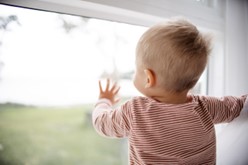Your child can from time to time, or sometimes more often than not, show signs of separation distress. Separation distress occurs when a child feels upset and can become visibly distressed when they are separating from a parent or caregiver. This can occur when you separate from your child with not only Educators at an early childhood centre, but it can also occur with familiar family members and friends. The good news is this is perfectly developmentally normal, and it doesn’t last forever!
Put yourself in your child’s shoes, you are passed over to an adult you have never met, in an environment you barely recognise, with many other children around. It’s loud, busy and you search for your Mum or Dad for reassurance, as they are your first love, your protectors. Oh wait, they are leaving. You are in the arms of a stranger. How do I trust someone I have never met?
The answer is through relationship building. Educators spend considerable time building positive and reciprocal relationships with children. It is through these relationships, through time spent together (even when the child is upset), that these bonds develop. Trust develops when a child is exposed to the considerate, caring and understanding responses of their Educators. This can only happen with time. The more time your child spends with their Educators, the more they will learn to trust them and their new environment. This in time means less distress they will feel when they need to say goodbye to you.

Something very important to remember is that distress at separation is not a negative thing. Even if the distress lasts for mere seconds or minutes. This is your child’s response to you saying goodbye. Their response is unregulated well because our children’s brain structures that support emotional regulation have not developed yet. For us, we can hold back our tears and logically reason that a situation is safe. Children cannot do this, so when they have fear or upset from having to say goodbye in an unfamiliar environment, their emotions are raw and visible.
What causes separation distress to occur in the first place?
Children’s distress can be developmental and/or can come from their lack of understanding of time, length of separation or unfamiliarity with the people or setting. Separation distress often begins to appear around 8-10 months of age as the child begins to develop the concept of “object permanence” (when an object or person disappears from sight they understand that it still exists even though they can no longer see it). This is a critical time in children’s brain development as they are becoming more aware of their social surroundings and form strong emotional bonds to their significant caregivers. As children are given repeated opportunities to experience separation and reuniting, the distress lessens or will disappear completely over time. Think of the first time you may experience something frightening, it is often less and less frightening the more you revisit it.
However, there can be times when your child who does not often display separation distress, suddenly does so. There can be a number of factors that can contribute to this sudden onset of distress behaviours. Some examples are:
• disrupted/bad night sleep
• Unsettled morning/rushing out the door
• Illness/feeling unwell in themselves
• Family member at home that normally isn’t
• Unfamiliar people around during separation
• Arguments or upset with friends from previous day
• Feeling out of control in a situation (busy, inattentive adults can make a child feel out of control/stressed)
• Out of routine (different/new days at the centre, family changes, being dropped off at a different time to usual, different educators etc.)
Understanding what may be triggering these behaviours is key to finding a positive solution to help ease the distress our child is feeling.

What can we do to support a child who is experiencing separation distress?
It is important to ease our child’s distress rather than distract away from it as this can cause greater distress. Have you ever been tempted to simply sneak away when your child seems settled? Imagine what your child may think when they turn around to see if you are there, to show you something or simply smile at you and your gone! They may search for you, cry out for you and when you are no were to be found, they become even more distressed not knowing who to turn to for help.
Instead we can try the following strategies to ease our child’s distress when we need to say goodbye –
• Promote secure attachments. Strong, supportive and reciprocal relationships allow the child to feel safe in unfamiliar or upsetting situations and will decrease the overall impact of and length of distress that may occur. Allow your child as many opportunities as possible to spend time with their Educators to build those relationships.
• Recognise and Respond appropriately to your child’s emotions. What your child is feeling is real and should be acknowledged and responded to calmly to reassure them that they are safe. If you are calm and confident in the moment than your child will feel more secure and trusting of the situation as they use us to guide their own understanding of the moment. Show trust in your Educator and acknowledge with genuine empathy your child’s emotions (e.g. “I know you are upset, I can see this hard for you. You are safe with your Educator, they will look after you”).
• Have a smooth, timely transition from parent to educator. If your child is showing signs of separation distress then the best thing for them in this moment is for a smooth and timely goodbye. If you stay for too long and linger with their emotions trying to distract them, the distress may often last longer. In these moments it is best to quickly say goodbye (using the advice in the point above) and allow the educators to soothe their distress once you have gone. This in turn helps strengthen your child’s bond with their Educators as they learn that they can be kept safe and soothed by them.
• Always say goodbye no matter how distressing. It can be VERY hard saying goodbye to your child when they are in tears. Knowing they may get upset when we say goodbye can lead you to want to sneak away when they are distracted. However, this causes mistrust between your child, the situation and you. They instead learn that when they settle and play you will disappear, so settling into the environment becomes more difficult as they anticipate your absence and try to avoid it. Whereas, if you say goodbye each time your child learns to predict the departure and will overcome the feelings more quickly as they feel reassured by your calm and confident approach to separations.
• Develop a goodbye routine. Children thrive on routine and consistency. It is one of the ways children feel secure in their world; knowing and predicting what happens next. A goodbye routine can be a wonderful strategy to implement when your child is experiencing separation distress as they can come to rely upon and take ownership over their routine. This may look like a wave at the door/window or security camera screen. This may also look like bringing a book from home to share upon arrival with their Educator. This could even look like a secret handshake between parent, Educator and child. Be creative, you know your child and listen to their input and you can create a beautiful routine to help soothe them during these times.
• Discuss what is going to happen at home. You may choose to prepare them for what they will experience the next day, talk about their friends, their favourite activities, what times you will be able to pick them up (for younger children this is best done by routine actions i.e. “I will be coming to get you after your afternoon tea”). This allows time for your child to process what will occur the next day. They are able to build on or prepare their coping mechanisms to help them when the separation does occur.
• Transitional/comfort objects. Having a cuddle toy or photo or another special item that your child holds dear to them can help them to transition into a new environment. Your child is able to seek comfort in the familiar item and regulate their emotions more positively. Transitional objects do not last forever, and as children become more familiar in their environment and the routine of separation they tend to leave them behind as they play.
Remember that separation distress is normal, although very hard for us as parents to have to witness, manage and experience. Speak with your child’s Educators about your experience and what your child is feeling and together you can develop a plan to put in place to begin easing your child’s distress and building strong reciprocal relationships with their Educators.
Written by Kelly West
Service Director and Partnerships, Inclusion and Research Coordinator
